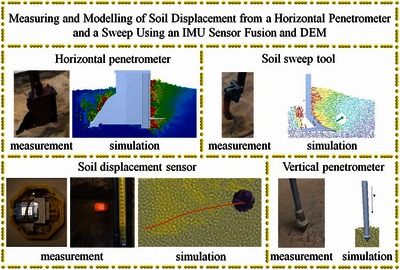Pásthy, László and Szabó, Bence and Tamás, Kornél (2024) Measuring and modelling of soil displacement from a horizontal penetrometer and a sweep using an IMU sensor fusion and DEM. Soil and Tillage Research, 244. No.-106207. ISSN 0167-1987 (In Press)
|
Text
Measuring and modelling of soil displacement from a horizontal penetrometer and a sweep using an IMU sensor fusion and DEM.pdf - Published Version Available under License Creative Commons Attribution Non-commercial No Derivatives. Download (21MB) | Preview |
|
![[img]](https://real.mtak.hu/204394/7.hassmallThumbnailVersion/graphabstr.jpg)
|
Text (graphical abstract)
graphabstr.jpg Download (275kB) | Preview |
Abstract
When simulating soil tillage processes using the discrete element method (DEM), it is essential to know the discrete element micromechanical parameters that describe the soil model, and this requires calibration. The formulation of a model that accurately reflects the behaviour of the soil from several perspectives is only possible by employing several different measurement procedures and DEM simulations. For this reason, four different measurements were used in this study for the purpose of calibrating the DEM model’s micromechanical parameters for sandy soil with a dry based moisture content of 4.1 %. The cone penetration resistance was measured with a horizontal penetrometer that was developed in-house and a vertical penetrometer, while a displacement sensor placed in the soil provided information on the internal movement of the soil, and the draught force of a sweep tool was also monitored. The DEM models of the measurements were defined in Altair EDEM® software using the hysteretic spring contact model. To model the soil, spherical elements and clump elements were examined. The displacement sensor was modelled with a clump element, whereas the sweep tool and the horizontal and vertical penetrometers were taken into account as rigid surface models. Based on the simulations, it was determined that the clump elements examined are not suitable for proper calibration with the hysteretic-spring contact model, because, as a consequence of the large coordination number, they excessively increased the draught force by getting stuck in front of the tools and measuring devices. By studying sweep tool simulations, it was observed that, in terms of the particle sizes used, particles with a higher density and higher bulk density resulted in a higher draught force, but at the same time, they moved at a lower speed. Finally, by taking vertical penetrometer measurements and running simulations, the soil model created with spherical elements was validated with a relative error of 8.7 % which can describe the sandy soil with sufficient accuracy in all the examined aspects.
| Item Type: | Article |
|---|---|
| Uncontrolled Keywords: | Discrete element method, Parameter calibration, Horizontal penetrometer, Vertical penetrometer, Soil displacement sensor, Sweep |
| Subjects: | S Agriculture / mezőgazdaság > S1 Agriculture (General) / mezőgazdaság általában |
| Depositing User: | Dr. Kornél Tamás |
| Date Deposited: | 06 Sep 2024 16:50 |
| Last Modified: | 06 Sep 2024 16:50 |
| URI: | https://real.mtak.hu/id/eprint/204394 |
Actions (login required)
 |
Edit Item |




